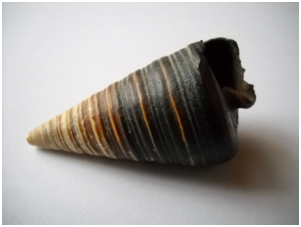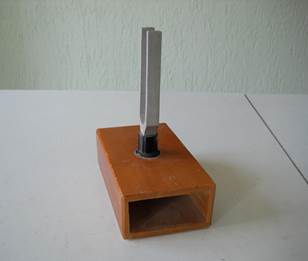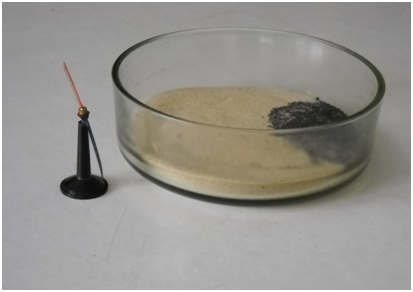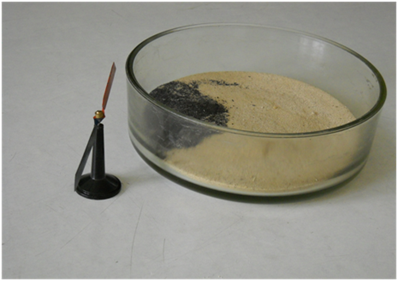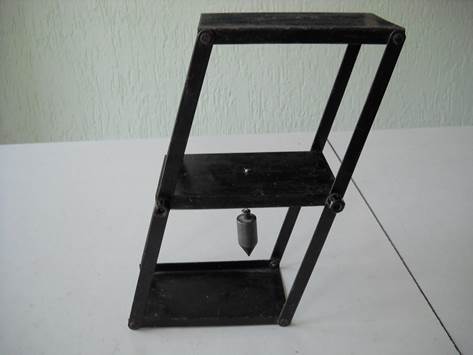Asia-Pacific Forum on Science Learning and Teaching, Volume 18, Issue 2, Article 5 (Dec., 2017) |
Phenomena of nature
Why we can hear the “voice of the sea” in the sea shell? (Biology: sea organisms, Physics: acoustic resonance)
It is known that sea shell contain an air (Figure A1). Ambient sounds excite the sound waves in this air. These vibrations resonate with the surrounding sounds. Strengthening and attenuation of sound vibrations in the sea shell creates the illusion of sounds tides.
Figure A1. Sea shell Figure A2. Tuning fork on resonance box We used the tuning fork on resonance box as a model of the sea shell. Tuning fork is set on resonance box for strengthening of sound vibrations (Figure A2). Air in box and tuning fork varies in resonance. Minimum length of air resonant column is equal to 1/4 wavelength of the sound in air. This numerical value determines the length of the resonance box.
Phenomena of everyday life
Football and gravity (Geography: latitude; sport: football; Physics: gravity)
Those interested in football, know that usually the team of any country plays better at home. Often this fact explained by the support of the fans. Consider some physical aspects of this game.
Imagine that the Ecuador national football team plays with the Ukrainian national football team. It is known that Ecuador and Ukraine are located at the different geographical latitudes θ and different altitudes h above sea level. Ecuador’s capital: Quito (θ ≈ 0°, h ≈ 2800 m), Ukraine’s capital: Kyiv (θ ≈ 50°, h ≈ 179 m). These and others reasons determine different values of gravity acceleration g in Quito and Kyiv. In this way, the values of gravitational acceleration g are equal to: gQuito = 9.77 m/s2, gKyiv = 9.81 m/s2. It is known that the magnitude of weight is given by formula: W = mg (1), where m is the mass of object, g is the gravity acceleration. We can calculate the weight of the football player and the weight of the soccer ball using formula (1). Assume that the mass of football player equals 75 kg. The weight of this football player equals 732.75 N in Quito, and equals 735.75 N in Kyiv (difference equals 3.00 N). Soccer ball has a mass 0.45 kg. It weighs equal 4.40 N in Quito and 4.42 N in Kyiv (difference equals 0.02 N).
What does the Ukrainian players feel when they arrived to Ecuador for the game? Their bodies have less weight, and the ball also has less weight in Ecuador. But the force of hitting on ball is remained the same because football players from Ukraine. All this leads to the fact that the ball flies along a trajectory, which unusual for them (above, further). So, do not be surprised that transfer of ball will be inaccurate maybe. Thus, the phrase “home team” has a real physical confirmation.
Link between theory and practice
Mineral exploration (Physics: the interaction of magnetic fields, Geography: minerals)
Iron ore in the surface of our planet increases the vertical component of the Earth’s magnetic field. Magnetic arrow is a model of magnetometer, by which scientists measure the Earth’s magnetic field. The jar with sand is a model of Earth’s surface. The metal filings are the model of iron ore. The presence of metal filings in sand affects on the orientation of magnetic arrow (Figure B1).
Figure B1. Magnetic arrow recorded the presence of iron ore in the Earth’s surface
Why Tower of Pisa not falling? (Engineering: construction of buildings, Physics: equilibrium)
Tower of Pisa has been built during about 200 years (from 1173 to 1360). The height of Tower of Pisa equals 55.86 m on the lowest side and 56.70 m on the highest. The slope from the vertical equals about 4.6 m. But the tower does not fall. Model of Pisa Tower can be demonstrated by the device “Slanted prism” (Figure B2). Prism remains stable when a vertical line, which comes out of its center of gravity, does not go beyond the area of basis.
Figure B2. Device “Slanted prism”

